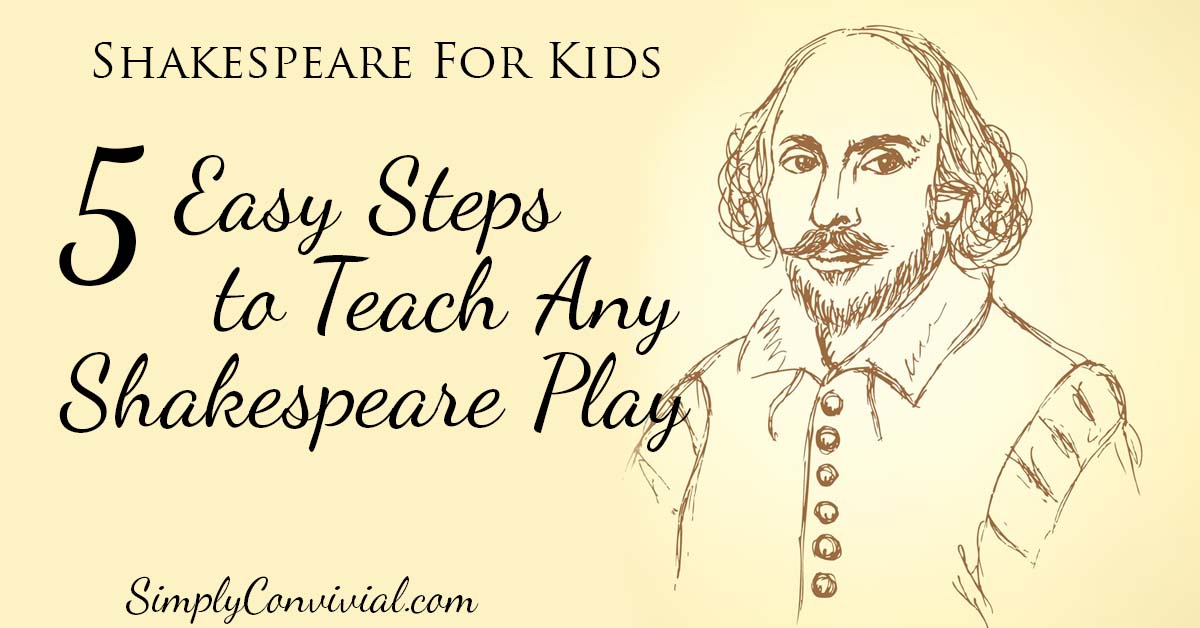The Tempest is a story with betrayal, revenge, reconciliation, and devotion. It has something for everyone: slap-stick humor, violent men & monsters, friendly sprites, and a fairy-tale island setting where forgiveness and keeping one’s word wins out in the end despite long odds.
Whether you introduce this story by picture book, movie, or reading the real deal – or all three – it is a story worth enjoying together with your children.
Shakespeare’s The Tempest for Kids
1. Introduce The Tempest
Start with a picture book retelling of the story to get not only the plot but also the feel of the semi-supernatural setting.


The art in these picture books is lovely and vivid, capturing the mood of the play.
2. Memorize Lines from The Tempest
Sometimes we think we have to understand something before we memorize it, but that’s not necessarily how our minds or our affections work. When we start with memorization, the familiarity brings gradual understanding. Knowing the lines by heart, we can think about them, rolling them over in our minds and letting not only the thought but simply the beautiful language sink in and resonate.
I chose two short sets of lines when I read The Tempest with my kids in our homeschool:
[pullquote align=”center”]
Full fathom five thy father lies;
Of his bones are coral made;
Those are pearls that were his eyes:
Nothing of him that doth fade,
But doth suffer a sea-change
Into something rich and strange.
[/pullquote]
and
[pullquote align=”center”]
How beauteous mankind is! O brave new world,
That has such people in ‘t.
[/pullquote]
Sign up and get instant access to all the Shakespeare memory sheets and lesson plans I’ve created to date.

3. Watch a Movie or Live Production of The Tempest
Yes, watching comes before reading the full play because Shakespeare was meant to be seen and not heard. It is much easier to keep track of who is who and what’s happening when watching the story unfold before your eyes than when all you have is the printed script in front of you.
The script was written for the actors, not for the audience. Although reading Shakespeare is a wonderful thing to do, it should never replace watching Shakespeare.
For a traditional production of this play, we watched the recorded stage production with Christopher Plummer.
Another version I enjoyed was the version done in 2011 starring Helen Mirren.


If you have older children, it would be fun to watch both versions and compare how the acting and setting changed the interpretation of various lines and the overall feel of the story.
Different families have different movie standards. Always watch the movies you plan to show your kids beforehand. Remember, they weren’t filmed specifically with children viewers in mind. They make great date night movies, too!
4. Listen & Read Along to The Tempest
Rather than simply reading a drama script aloud to my kids, we listen to an audio version – preferably one with different characters read by different people (it helps us keep track) – and follow along in our own individual copies of the text.
Reading with the eyes while listening with the ears helps enrich language skills. Spelling and pronunciation is reinforced with vocabulary we don’t encounter every day, and in an enjoyable rather than a test-focused activity.
I prefer using plain, cheap Dover thrift editions for reading along with the audio version so that the children aren’t distracted by the extra information given in many editions or the explanations of puns I don’t necessarily want them to understand yet. Adult humor can be for adults, going over the heads of the children, and that’s perfectly acceptable.

We used the Arkangel version of The Tempest, purchased with our Audible membership.
5. Play The Tempest
The Tempest provides many fun scenes that would be a blast to act out for kids. Boys will arm wrestle over who gets to be Caliban and who the Magician. Girls will vie over Miranda or Ariel scenes. It doesn’t take many kids to put together a few select scenes, and you could even simply play the audio of the text and allow the kids to mime their chosen character, acting the part with appropriate facial expressions and movements.
Telling the story with Lego people or finger puppets or drawing the story as a comic strip are also great reinforcing activities that allow the child to put his own artistic spin on the classic tale.
Put it together: Lesson Plans for The Tempest
Class Time: 20 minutes, 2 times a week (plus time to watch the movie)
Total length: 8 weeks
Class Procedure
- Repeat the lines to memorize together once or twice
- Do the day’s lesson
- Ask a question to get a narration/discussion going for a few minutes
Class Lessons
- Read 1/2 the picture book. Have a student narrate.
- Ask each student to name & describe a character. Read the rest of the picture book.
- (over the weekend, have a movie night)
- Discuss the story, plot line, and movie – ask kids for favorite parts or characters. Let them ask questions.
- Listen to 15 minutes of The Tempest on audio while following along. (The Tempest is 2 hours 11 minutes, so this will take 10 class periods).
- Have students present either mimed or play acted scenes or present artwork done to tell the story.
Remember that prior to high school, our goal is simply to introduce the stories and Shakespeare as something to enjoy together. There will be no fear or intimidation when they’ve grown up with the assumption that Shakespeare is fun and normal rather than difficult and enigmatic.
So lighten up and remember that the point is being interested and engaged with the intriguing stories Shakespeare tells.
Shakespeare Lesson Plans
As we study Shakespeare plays together in our homeschool, I am making available our lesson plans and resource lists. Here are the links to each of the plays we’ve studied so far. Included in each one is a downloadable pdf set with not only the lesson plans, but also the printable quote cue pages we use for memorizing select lines from each play!
- How to teach Shakespeare to kids in 5 easy steps
- Comedy of Errors Lesson Plans
- Henry V Lesson Plans
- Hamlet Lesson Plans
- Julius Caesar Lesson Plans
- Taming of the Shrew Lesson Plans
- The Tempest Lesson Plans
- Macbeth Lesson Plans
- Merchant of Venice Lesson Plans
- A Midsummer Night’s Dream Lesson Plans
- Much Ado About Nothing Lesson Plans
- Mystie chats about enjoying Shakespeare in your homeschool on Your Morning Basket with Pam Barnhill




